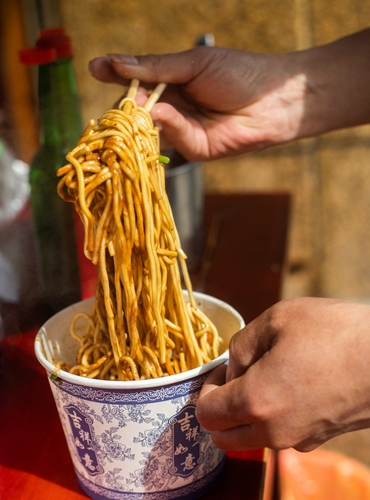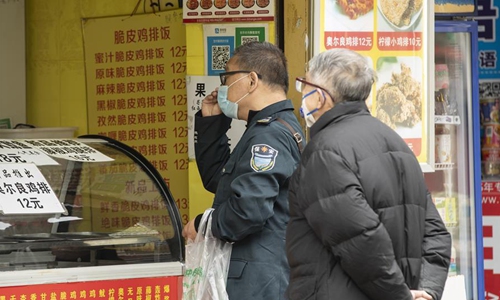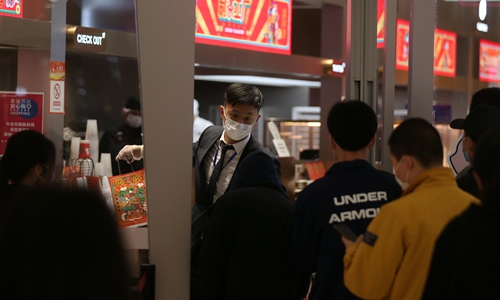24 hours before Wuhan to lift traffic lockdown
Not time to ease full-scale restrictions

A local resident eats reganmian, the most popular hot noodle dish in Wuhan, Central China's Hubei Province. Life is getting back to normalcy as many restaurants and shopping malls in Hubei have resumed work and residents have begun to go outside to "guozao." The word "guozao" is a popular term in Wuhan dialect for eating breakfast, which appeared in mid Qing Dynasty (1644-1911). Wuhan locals have still kept this custom. Photo: IC
Wuhan, capital of Central China's Hubei Province that has hit the "pause" button for 76 days since the novel coronavirus outbreak began, will resume outbound transport in less than 24 hours.
For local residents, Wednesday (April 8) will see the resumption of normal life after more than two months of isolation, even as epidemiologists warned that it is not the time to completely lower the guard and ease on full-scale restrictions, especially for community-based epidemic control work, considering the looming asymptomatic patients and possible rebound in infections.
Wuhan authorities announced it will lift harsh and tough restrictions on Wednesday while local airport and train stations are scheduled to resume operations after the unprecedented 76-day city lockdown that helped slow the virus' transmission to other parts of the country and delayed the spread to other countries, as a recent medical journal estimated, by nearly 80 percent.
Restarting the normal life in China's hardest-hit city amid the novel coronavirus pneumonia (COVID-19) epidemic will be a milestone for the overall prevention and control work in the country, which has also been highly expected by local residents, Wang Zhonglin, Wuhan's Party chief, told a meeting on Sunday.
However, this does not mean that epidemic prevention and control work could be relaxed and authorities have to continue carrying out strict community-based monitoring and management, making sure that a rebound in new infections won't occur following the traffic resumption, media quoted Wang as saying.
While more local residents started a countdown to the end of the city lockdown by sharing their personal feelings about the past two months in isolation, some with palpable excitement, epidemiologists, local doctors and officials warned that this is not the time to cheer as the understanding on the virus is far from being sufficient and increases in new infection cases as well as in asymptomatic patients are also alarming.
It may also take longer for Wuhan people to ease the psychological impact of the epidemic. On Saturday, the country paused for COVID-19 victims with three minutes of silence to honor and remember the ordinary heroes, giving courage and reflecting the solidarity of the Chinese people to overcome such a difficult time together, some local residents in Wuhan said. And any smear campaign or reports hyping the number of deaths can't be tolerated.

People buy food in Wuhan, capital of central China's Hubei Province on Wednesday. Life in Wuhan is gradually back to normal as the coronavirus outbreak wanes. Photo: Xinhua
Back to normal
"Long time no see, Wuhan to restart in two days," read posters shared by online users on social networks in recent days while local people in Wuhan also shared pictures and personal stories such as bus rides, going to Starbucks, visiting an iconic Wuhan breakfast shop and enjoying hot dry noodles - signs that life is gradually returning to normal.
Major commercial districts are regaining vitality as the epidemic wanes with shops reopening to visitors. Local authorities have conducted disinfection work at railway stations and the airport before those places resume operations while hundreds of bullet trains are ready to provide services.
"We've experienced this unforgettable period, it's not easy, but we made it," Huang Yan, a 30-year-old local resident who underwent self-quarantine at home since January 23, told the Global Times on Monday.
Huang said it was the second day since he returned to work after his company gave him a personal certificate with which he could leave the residential compound where he lives. "Before returning to work, we need to apply for a green health code on my smartphone. By scanning the code and showing the certificate at the entrance of my residential building, I could go out," he said.
"Everywhere I go, I need to scan a QR code, then those places I visit would be on the record," he added.
Several local officials from the community-based prevention and control work unit in Wuhan told the Global Times that lifting the city lockdown does not mean local authorities would relax restrictions on residential communities, and seal-off management will continue as social workers and local officials also need to keep an eye on asymptomatic patients.
Places like restaurants, hotels, shops, buses and subway stations ask local people in Wuhan to scan their health code to register each person's trajectory to monitor transmission routes if a confirmed patient is found with a similar trajectory, which shows that China uses big data to track down coronavirus infection cases.
"Local people in Wuhan use the health code and are prepared to gradually resume work and return to normalcy. Restarting Wuhan also shows that China has placed the epidemic under control," said Yang Zhanqiu, a virologist at Wuhan University.
Social distancing, application of big data, awareness of individuals and overall mobilization are major steps which prove China has made significant progress in this fight and helped score phased victory.
However, some top experts warned this is not the time to take a rest, considering the looming challenges in preventing a rebound.
Wang Chen, an expert from the central government's work group to Wuhan, told a recent forum that there is still a lack of understanding of the novel coronavirus and of its transmission routes. People should stay vigilant of a possible rebound.
An employee from the disease control and prevention center in Wuhan's Donghu hi-tech district told the Global Times on Monday that they are now focusing on screening silent carriers.
"We asked factories and companies to conduct health checks on returnees. Once a case is confirmed, the investigators will ask about the patient's travel history and give each one a report, and analyze their possible contagion origin," said the employee who preferred not to be identified.
She noted that they have only examined returnees to factories, because screening asymptomatic patients requires a huge amount of work, stressing that as the ban is gradually lifted in Wuhan, residential communities are also required to keep a close eye on asymptomatic patients.
"Relaxing the traffic ban doesn't mean loosening regulations on virus control. Risks of asymptomatic patients may just be the tip of the iceberg," the employee said.
The National Health Commission reported on Monday 78 new asymptomatic cases, of which 40 were imported and five have become confirmed cases. As of Monday morning, China had 1,299 confirmed cases.

After two months confined at home, residents in Wuhan queue up in front of a milk tea shop when the city's shopping areas begin to reopen. Photo: Cui Meng/GT
Unforgettable memory
China held a national day of mourning on Saturday, China's traditional Qingming Festival - also known as the tomb-sweeping festival - to commemorate the 3,335 victims so far of the COVID-19 epidemic, including medical workers and police officers who sacrificed their lives during the battle against the epidemic in the country.
People in Wuhan stood still at 10 am for three minutes, during which all traffic lights were set at red, and air raid sirens and horns of automobiles wailed in grief. Some people shed tears, as deep sorrow remains, and some were overcome by painful memories of their loved ones.
However, some US media claimed that local authorities banned huge crowds to mourn for their losses. The Washington Post reported on Saturday that the Wuhan authority's ban of crowds at cemeteries is the government's way to deny family members to gather to complain about the government's handling of COVID-19, and linked it with China's alleged underreporting of death numbers.
"This is an insane report. Anyone with a basic knowledge of public health should know now is not the right time to gather at cemeteries to mourn the deceased, and people nationwide were urged to use online mourning to avoid mass gatherings and possible further contagion," said a Wuhan resident surnamed Zhao.
Zhao said her family went downstairs on Saturday for the first time since the lockdown, to burn joss paper (a tradition in China as an offering to deceased family members so that they can better enjoy the afterlife) for her mother-in-law, who died of the virus in February.
"Due to the current circumstances, we dare not go to the cemetery. So we burned it at our residential compound. Others went to the river, to toss carnation paddles for the deceased, and mourned the medical workers who died during the fight," Zhao said.
Wuhan's public funeral homes helped residents mourn, as they filmed placing flowers and ribbons in front of the tombstones, and bowing to descendants.
A New York Times report on Friday claimed that China assigned minders in Wuhan to relatives of the deceased, to follow them as they pick burial plots, claim their loved ones' remains and bury them. The newspaper claimed it was meant to monitor the family members, and to avoid an outpouring of anguish and anger.
Zheng Shuqian, an employee at one of Wuhan's community healthcare centers, who also accompanied residents to collect urns, said that because traffic was banned in Wuhan during the lockdown, the government had assigned special taxis for residents since January.
After the funeral homes opened, the government added more taxis to each community, and assigned community service employees to keep family members company on their way to collect urns.
"Because some family members have to squeeze into one taxi to the funeral home, the community service employee had to come to coordinate, and to take them to the cemetery, and come back to pick up the next group," Zheng said.
Hu Xi, 28, who was born and bred in Wuhan, said the city was engulfed by a siren, which blared at 10 am on April 4, the start of the nationwide commemoration for COVID-19 victims. "The siren, coupled with a bell tone from afar, amplified the somber atmosphere. But the three-minute commemoration was like a ferry, contained the trials we endured and then slowly drove them away," Hu said.
Wuhan's tomb sweeping festival has come with a drizzle in the past years. But it was a sunny day on Saturday, Hu said.
"I believe it's a good sign for Wuhan people to walk out of the haze, and to embrace a brighter future."